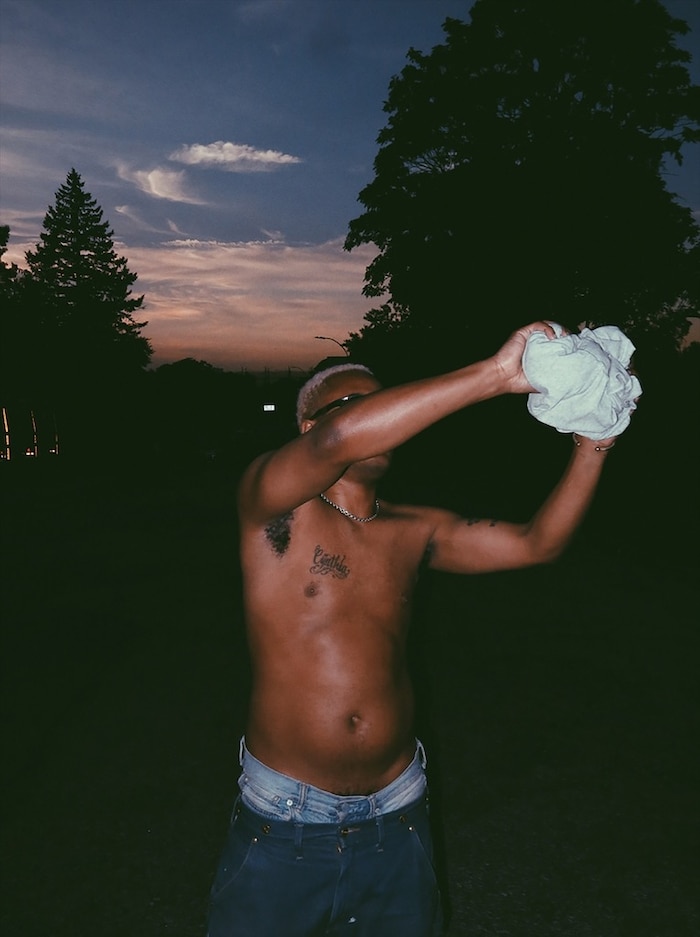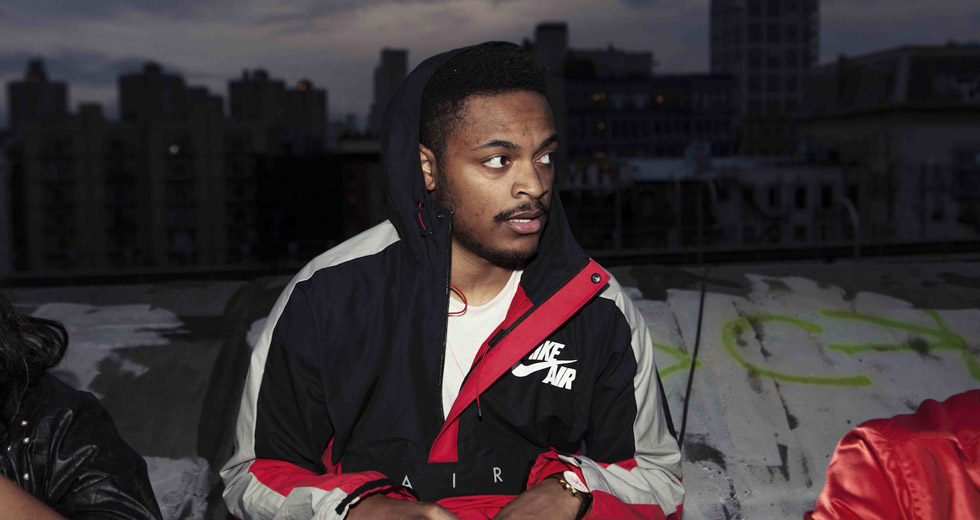Dedekind Cut on Lee Bannon, Ambient and Emoji Track Titles

Many musicians are stylistically difficult to pin down, but Lee Bannon takes aesthetic experimentation to another level entirely. The Brooklyn-via-Sacramento artist followed up his mutated jungle hybrids and state-of-the-art boom bap for MCs like Joey Bada$$ by diving into industrial-tinged soundscapes and other far-afield territories while adopting new noms de plume – including Dedekind Cut and ¬ b – for a variety of albums and labels. In this excerpt from The Slice, RBMA Radio’s monthly local spotlight on New York, he analyzes his fluctuating artistic identity.
Listen to The Slice on RBMA Radio here every first Wednesday of the month at 11 AM EDT.
When did you start using the Dedekind Cut moniker? It was about a year ago?
Yeah. About a year ago. I always had plans of multiple monikers, but this one, specifically, I was just making a ton of ambient stuff, more drone and noise stuff. I guess, yeah, like a year ago with Thot eNhançer, which has a little bit more breakcore stuff but some ambient moments. It was like a transition. I think American Zen is where it actually came to full form and has full-on new age and ambient properties, I guess.
Did you make the song “American Zen” while on or influenced by ayahuasca?
No, which – I sound like a poser. People involved in the session had, and that’s kind of what inspired it. Actually, if you go back and listen to it, it’s kind of like a choir of just friends. Alex [Zhang Hungtai] had the idea of everyone kind of chanting to this piano melody that he wrote at my house. Then we just mic’d it all up.
So the EPs were a progression?
Oh, yeah, yeah. The EPs were kind of meant to create a story. It’s like the transition from what everybody was used to as Lee Bannon into this new moniker. It’s hard to start from scratch. Basically, you’re a new artist. I wanted people to be kind of in a certain mindset and ready to hear a certain style of music that’s different from Lee Bannon.
Part of that transition was letting people into what I’d been listening to, what I’d been creating and not putting out because it didn’t fit a certain aesthetic as Lee Bannon or whatever, certain people I’d been working with or been friends with, like Chino [Amobi] or Rabit, share a lot of those collaborations, not all music collaborations, but just make the world aware of that, because it’s all necessary, I feel like, before going into listening to an album like $uccessor, which is pretty deep. You could either fall asleep to it or meditate to it or whatever you want to call it, or you could just pay attention to all the little drums and little things going on. It could either help you do what you’re doing or distract you, depending on how you listen to it. All those other records were definitely like a necessary precursor.
When you released Pattern of Excel, which was your last record as Lee Bannon, you said, “Music I compose in the future can no longer exist in the realm, any longer with music I composed when I was 17.”
Right. I was frustrated with how it was perceived, not by the people, but by retailers like Pandora or Spotify or iTunes. If you would put in “Lee Bannon” into Pandora, they’d play Lil B, Joey Badass and then drum & bass. It was just so all over the place that I had to step back. If I put on Brian Eno, I’m expecting a certain experience, and I wanted to kind of build that up. The experience you’re getting from Lee Bannon – as far as all those other mediums go – was kind of chaotic and inconsistent. It was making it more difficult to even perform live. People didn’t know what to expect.
Maybe a lot of those platforms are just set up for single-lane genres, and as soon as you start crossing over, it messes up the algorithm... I think I’m just kind of really into the idea of building a catalog that’s cohesive and a body of work that could be played from front to back. As Lee Bannon, I was learning; learning new styles, meeting new people. Moving to New York was a huge...
Zach [Hill from Death Grips] is a big inspiration. I feel like once he has a vision he goes about it in the best possible way.
When did you move to New York? Did you come out her because of your affiliation with Joey Bada$$?
This was 2012, and that was huge, because I went from being a fan of a lot of this stuff... We played the Jimmy Fallon show and we ended the tour here, and I just ended up staying. I made a bunch of really strong bonds here, like work ties. I was meeting with different labels; it just seemed like the place to be at the time; to plant my feet and really build a foundation for a career with some type of longevity.
Going back to growing up in Sacramento, tell me about your exposure to music.
I listened to a lot of different things, but the music I ended up making was more similar to my peers, so it wound up being more hip-hop-oriented, but by the time I got to New York and was doing the Joey stuff, I was pretty disenchanted with doing the same hip-hop-by-numbers tracks, so I really wanted an outlet to just release this experimental and genre-bending style stuff.
I read there was a drum & bass scene in Sacramento.
Yeah, I got into it because of people like DJ Whores who’s older than me but a very big fixture in the Sacramento electronic community at the time. I remember Zach Hill from Death Grips stayed pretty close to me, and we would speak and he was kind of into that stuff as well. This was 2009 or 2010, but it was way before I became an adult. It was definitely a thing when I was in high school and junior high school, definitely a thing in a more Juggalo way I guess, but it was a thing.
Yeah, it’s funny watching the evolution of Death Grips, or I guess their passage across space and time.
Yeah, Zach is a big inspiration. I feel like once he has a vision he goes about it in the best possible way. In a way that’s not compromising and is original, because a lot of times doing this... I’ve made music on two levels, a very high-end Sony industry level and I’ve done it on the level I’m doing this record. Submitting a record and having people say, “Oh, you can’t do this, you can’t have a track title this long or a song this long, this should be better here. Shorten your album because you want it to fit on vinyl.” It’s like all these rules that you get, the higher the establishment that you’re releasing it with is. So yeah, I like forging new rules. Even on this album there’s an emoji on the tracklist.
I saw that, is that a yin yang?
Yeah, and even that was a battle but I pushed it through and sat and spoke with iTunes, speaking with Spotify and all this stuff.
Really? So you had to sort of defend your artistic vision to them?
Not defend, but approach them with the idea, instead of being with a bigger label and them being too lazy to try to even attempt to just ask, you know? Coming from a situation where I was with a label like Ninja Tune or whatever, they have their ways and they know what works. I’m very experimental in the way that my mind works. I want to push the boundaries a little bit more. If I like the way an emoji looks... Instagram exists, all these things exist now and we communicate with these things, they’re symbols so why can’t it represent something or a title of something? They understood that and it’s here as the title.
You’re also speaking about the album roll-out earlier and how it’s been different, you’re coming out with Dedekind Cut yoga mats, and also you made this massive Spotify ambient playlist.
Yeah, which I’m continuing to edit and expand and make bigger and bigger. I’ve been getting a lot of emails about that and people actually submitting tracks to me to put in the mix itself, and I’m glad it has a following because I remember even studying in school... whenever I have anything to work on I always put it on. I can be cleaning, I can be on a call, it definitely helps the work flow and focuses what I’m doing a lot. I’ve done mixes like this for years for my own personal use on plane rides, tour, but it’s good to be able to share it and have it also be evolving in real-time.
